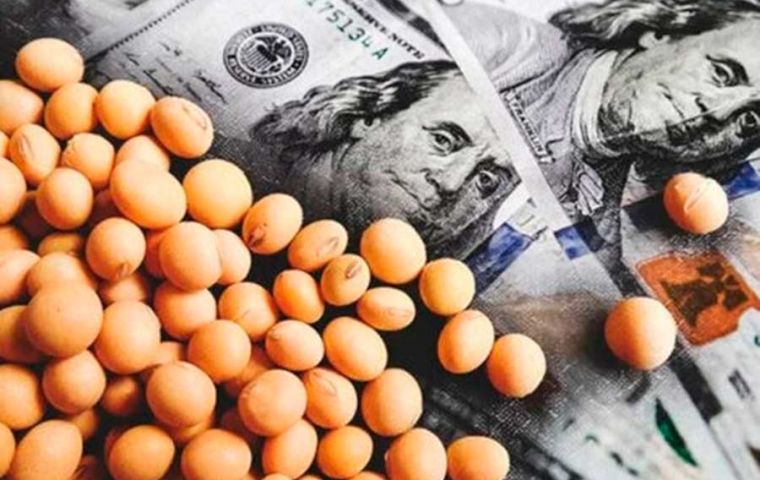MercoPress. South Atlantic News Agency
The September “soy dollar” convinces Argentine farmers to sell their crops
 With the implementation of the “soy dollar” during September by the government of Cristina Kirchner, farmers have started to sell their retained millions of tons
With the implementation of the “soy dollar” during September by the government of Cristina Kirchner, farmers have started to sell their retained millions of tons Argentine farmers have sold 15.2% of the country’s 44 million-ton 2021/22 soy crop in seven days since the government implemented a more favorable exchange rate for cash crop exports, Rosario grains exchange reported.
Argentina is the world’s largest supplier of soybean oil and meal, and its growers held back more soybeans than usual, owing to the uncertain Argentine economic situation, which includes an anticipated inflation of three digits for 2022, plus a frozen foreign exchange rate with a 120% gap between the official and blue (black) market rate.
With a worthless currency and ever greater impediments to access to hard currency (US dollars in Argentina), farmers preferred to keep their crops, mainly soybeans, in portable bag silos. The soy crop in Argentina was estimated at 44 million tons, and probably up to half that volume remained unsold.
In the meantime the administration of president Alberto Fernandez and vice-president Cristina Kirchner remain desperate for foreign currency to keep the economy working with crucial imports, since the Central Bank balance of international reserves is negative. With money printing at top speed to pay for an over bloated budget, Argentines get rid of their Pesos or keep to dollar valued assets such as crops.
However the government in desperation finally agreed to a more favorable exchange rate for farmers, the so called “soy dollar”, while at the same time accepting in Washington IMF suggestions to straighten the down trodden Argentine economy.
“Since the beginning of the Export Expansion Program, 6,680,036 tons have been shipped until last Tuesday (13),” the Rosario Grains Exchange reported, pointing out the volume was extracted from statistics.
But as of Monday (September 5), when the “soy dollar” becomes effective, farmers will enjoy during the current month an exchange rate of 200 pesos to each dollar obtained from soybean sales, well above the regular official 142.8 pesos exchange rate. Argentina as a net exporter of agriculture commodities needs to rely on the country's most fertile soils.
According to the Ministry of Agriculture, by Wednesday of last week, farmers had sold 56.9% of the total soybean 21/22 harvest, approaching the rate of grain sales of the previous year’s cycle, which on the same date had been 63.9% of the total.




Top Comments
Disclaimer & comment rulesCommenting for this story is now closed.
If you have a Facebook account, become a fan and comment on our Facebook Page!